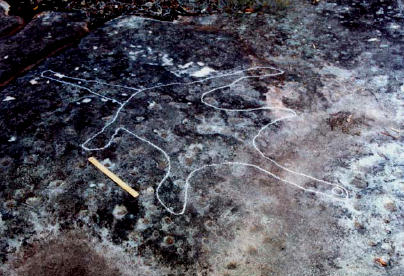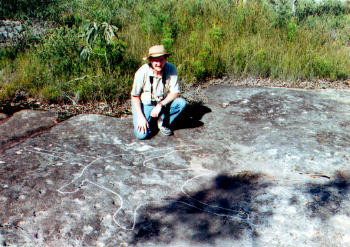Research of Australian Reptillian Water Monsters
Entire Website © Rex & Heather Gilroy | URU Publications ® ™ Rex & Heather Gilroy 2010. All Rights Reserved
Snakelike Head
During 1977, two fishermen in a small boat in Broken Bay became startled when a large snakelike head of terrifying appearance, and about 1.5 metres wide, momentarily surfaced a few metres from them.
Dharuk Art |
|---|
Fossil Record |
| Eyewitness Accounts Below |
| Pre-1950 | 1950-79 | 1980-2010 |
| Newspaper Accounts |
| New Zealand |
| New Book Out Late 2010 Early 2011 |
| Report Sighting |
“ Nessie” Lives in a Sydney River
For thousands of years, the former Dharuk tribal Aborigines of the central coast, north of Sydney, preserved traditions of enormous reptilian 'water monsters' which, they told early European settlers last century, inhabited the nearby Hawkesbury River. Their ancient cave art along the river includes depictions of these mystery creatures, which they called "Mirreeulla" ("giant water serpent"), described as having a snakelike head, long neck, a large body with two sets of flippers, and a long eel-like tail. The Aboriginal description of these animals also matches that of European sightings of the creatures since last century, from Wisemans Ferry at the western end of the river, eastward to the Broken Bay-Brisbane Waters expanse at the river's mouth.
I have had an almost 45-year-long fascination with the`water monsters' of the Hawkesbury River, during which time I have gathered over several hundred reported sightings of the creatures dating from last century to the present-more than enough to convince me that they are no mere mythical Aboriginal 'bunyip', but living survivors from geological times.My researches into these mysterious creatures many years ago led me to coin the name "Hawkesbury River Monster? in describing them, and the name has stuck. The general physical description of the "Mirreeulla" is unmistakable: they resemble the Plesiosaurus, or some ancient marine reptile very much like it.
Scientists who ridicule the plesiosaur survival theory, and dismiss outright our very own Hawkesbury River "Nessie" as nonsense, should recall the Coelacanth, the fish once thought extinct since dinosaur times until a living specimen was caught off the African coast in 1938. This fact leads zoologists to speculate that many more species of long-thought-extinct or as-yet-unknown species of sea life still await discovery in the ocean depths.
That a form of marine reptile from the age of dinosaurs could still survive in the Hawkesbury River must, understandably, seem absurd to many people. Yet, when one considers the often enormous widths, the great depths, the length of the river (up to 120 kilometres) and its many branches snaking off in all directions, there is more than enough room for such creatures to have survived and bred undisturbed for centuries, as the following case histories suggest.
One hears so many stories along the Hawkesbury of sightings of 'long necks', of vanished fishermen and others, of vessels overturned by some submerged giant beast; and although some tales may be questionable to some, there still remain a great many, quite believable cases-enough to suggest that there really is something lurking 'down there' in those almost bottomless depths of this sunken valley of geological times.

|
|
Continued From Above Right Hand Column
Like the Aboriginal Mirreeulla, the Taniwah and Kureea are depicted as serpent-headed,long-necked, large-bodied creatures with two sets of long flippers and long tails. This cannot be put down to mere coincidence, and with sightings reports of Plesiosaur-type sea creatures being made worldwide, it is obvious that the mystery is by no means confined to a certain Scottish loch. In this light, the Hawkesbury River Monster assumes a worldwide perspective which, like its Pacific region cousins, deserves far more scientific attention than it has been given to date.
Despite the disbelief of the scientific establishment, sightings of these zoological throwbacks from the Age of Reptiles continue into the 21st century. My Hawkesbury River investigations continue to turn up new information. But so far, to my knowledge, no photograph has been taken of one of these animals. In an effort to gather whatever evidence possible, in 1978 I established the Hawkesbury River Monster Survey which continues to the present day.


